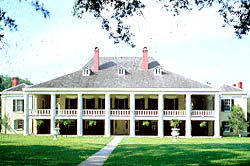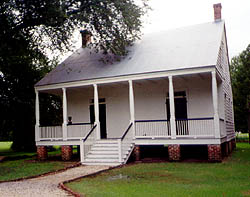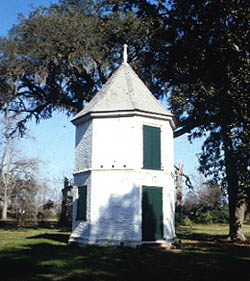|

 
|
 Destrehan Plantation is an excellent example of the French Creole
architectural style
Destrehan Plantation is an excellent example of the French Creole
architectural style
Photograph from the National
Historic Landmarks collection
{photo2}
Rear
view of historic site
{courtesy2} |
French Creole architecture is
one of the nation's three major colonial architectural traditions. It
takes its place alongside British Colonial, as exemplified by the saltbox
houses of New England and a later generation of Georgian houses, and Spanish
Colonial, as seen in the missions of California and the Southwest. The
French Creole building tradition appeared in New France, i.e., in the
United States, the Mississippi Valley. Because the region was sparsely
settled at the time, very little French Creole architecture was built
outside Louisiana. And today Louisiana is home to the overwhelming majority
of surviving examples.
There is much scholarly dispute as to the origins of the French Creole
building tradition. Some have noted distinct similarities to buildings
in France while others emphasize the evolution the tradition underwent
in the New World, principally the Caribbean. Regardless of its origin,
it is a distinctive building tradition characteristic of French America.
French Creole architecture, of course, began in the French colonial
period (1699-1762). However, the tradition continued in popularity well
into the 1800s. By the 1830s and 40s, one sees houses that combine French
Creole features (see below) and Anglo-American traditions such as symmetry
and a central hall plan.
|

Parlange Plantation, another good
example of the French Creole style
Courtesy of the Louisiana Division of Historic Preservation
|
The typical rural French Creole house can be described as follows. Its
most important features include: 1) generous galleries, 2) a broad spreading
roofline, 3) gallery roofs supported by light wooden colonnettes, 4) placement
of the principal rooms well above grade (sometimes a full story), 5) a
form of construction utilizing a heavy timber frame combined with an infill
made of brick (briquette entre poteaux) or a mixture of mud, moss and
animal hair called bousillage, 6) multiple French doors, and 7) French
wraparound mantels. The previously mentioned timber frame incorporated
French joinery i.e., angle braces that are extremely steep, running all
the way from sill to plate, in contrast to English joinery where the angle
brace is almost a 45 degree angle.
|

Aillet House, an example of a small,
Creole plantation house
Courtesy of the Capital Resource Conservation and Development
Council
|
Urban examples shared most of these characteristics but often lacked commodious
galleries. Indeed, the quintessential Creole cottage in New Orleans stands
flush with the front property line and has no gallery. Also, urban areas
had what is known as a Creole townhouse, a multi-story, typically L-shaped
building standing flush with the sidewalk. The first floor served as mercantile
space and the upper floors as the family's living quarters. Some Creole
townhouses had a low mezzanine-type storage area known as an entresol
located between the first and second floor. A wide carriage passage connected
the street to a rear courtyard. Today surviving Creole townhouses can
be seen mainly in New Orleans' French Quarter.
Creole floorplans are distinctive in the following respects. They tend
to be asymmetrical and always lack interior hallways. Openings are placed
solely for the convenience of the interior, and without any regard for
a pleasing architectural effect on the exterior (i.e., producing an
irregular schedule of openings). Often the rear range of rooms consists
of an open loggia with a small room at each end known as a cabinet.

Pigeonniers denoted wealth among the
rural French Creole,as in France only landowners had the right to
have pigeons under the Old Regime
Courtesy of the Louisiana Division of Historic Preservation |
|
The rural French Creole building tradition is also known for the use of
pigeonniers to ornament the plantation. Domestic pigeons had value not
only as a delicacy but as a source of fertilizer. However, as noted by
Louisiana plantation specialist Barbara Bacot, it was less a taste for
squab than for status that exalted the pigeonnier. Bacot, in Louisiana
Buildings, 1720-1940, notes that in France only landowners had the
right to keep pigeons under the Old Regime, and some of the landed gentry
chose to frame their houses with pairs of dovecotes. In Louisiana, pigeonniers
used in the form of monumental towers set near the main house continued
as a fashion well into the 19th century. By contrast, on English plantations,
where birds were sometimes kept, the roost or dovecote would typically
have been little more than nesting boxes set in the gable of the barn.
Essay written by the Louisiana Division of Historic Preservation
|



 Destrehan Plantation is an excellent example of the French Creole
architectural style
Destrehan Plantation is an excellent example of the French Creole
architectural style




